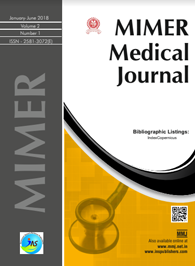Original Article Patients’ perspective of barriers to participating in Supervised Exercise-based Cardiac Rehabilitation Program: A Qualitative Study
Patients’ perspective of barriers to participating in Supervised Exercise-based Cardiac Rehabilitation Program: A Qualitative Study
Keywords:
Cardiovascular Diseases, Chronic Diseases, Health Systems Reform,Abstract
Background: Benefits of the cardiac rehabilitation program are well documented in the literature. Despite proven benefits, enrollment rates in cardiac rehab programs remain low. Patient perceived barriers influencing the enrollment rates in cardiac rehab programs remain unclear.
Purpose: Underutilization of cardiac rehab facilities remains a major problem. Identification of patients' perceived barriers to participating in supervised exercise-based outpatient cardiac rehabilitation programs, will help in developing strategies to improve the enrollment rates and to increase the utilization of cardiac rehabilitation services. This study aims to record the barriers faced by patients by conducting focused group discussions.
Methods: We conducted five focused group discussions (FGD’s) until we reached the saturation point. FGDs were conducted as per the standard guidelines. Discussions were recorded by the note keeper and later transcribed. Thematic analysis was done to identify the barriers perceived by the patients to attend the supervised outpatient cardiac rehabilitation programs.
Results: After analyzing the verbatims, we identified seven different themes as patient-perceived barriers to participating in supervised exercise-based outpatient cardiac rehab programs. 1. Transport distance, time & cost 2. Lack of Family support 3. Lack of Interest, 4. Work timings 5. Financial constraints 6.Comorbid Conditions 7.Willingness
Conclusion: Reaching the cardiac rehab facility, lack of family support to reach and undergo rehab, lack of interest in joining the program, unsuitable work timings, financial constraints, disabling comorbid conditions, and willingness to join the program are the patient-perceived barriers to participate in supervised exercise-based outpatient cardiac rehab programs
References
REFERENCES
Khan MA, Hashim MJ, Mustafa H, Baniyas MY,
Al Suwaidi SK, AlKatheeri R, et al. Global epidemiology
of ischemic heart disease: Results from the Global Burden
of disease study. Cureus 2020;12:e9349.
Gupta R, Mohan I, Narula J. Trends in coronary heart
disease epidemiology in India. Ann Glob Health
;82:307-15.
Moran AE, Forouzanfar MH, Roth GA, Mensah GA,
Ezzati M, Murray CJ, et al. Temporal trends in ischemic
heart disease mortality in 21 world regions, 1980 to 2010:
The global burden of disease 2010 study: The global burden
of disease 2010 study. Circulation 2014;129:1483-92.
Gaziano TA, Bitton A, Anand S, Abrahams-Gessel S,
Murphy A. Growing epidemic of coronary heart disease
in low-and middle-income countries. Curr Probl Cardiol
;35:72-115.
Le J, Dorstyn DS, Mpfou E, Prior E, Tully PJ. Healthrelated quality of life in coronary heart disease:
A systematic review and meta-analysis mapped against
the international classification of functioning, disability
and health. Qual Life Res 2018;27:2491-503.
Roth GA, Mensah GA, Johnson CO, Addolorato G,
Ammirati E, Baddour LM, et al. Global Burden of
cardiovascular diseases and risk factors, 1990-2019:
Update from the GBD 2019 study. J Am Coll Cardiol
;76:2982-3021.
Wenger NK. Current status of cardiac rehabilitation.
J Am Coll Cardiol 2008;51:1619-31.
Sérvio TC, Britto RR, de Melo Ghisi GL, da Silva LP,
Silva LD, Lima MM, et al. Barriers to cardiac rehabilitation
delivery in a low-resource setting from the perspective of
healthcare administrators, rehabilitation providers, and
cardiac patients. BMC Health Serv Res 2019;19:615.
Chindhy S, Taub PR, Lavie CJ, Shen J. Current challenges
in cardiac rehabilitation: Strategies to overcome social
factors and attendance barriers. Expert Rev Cardiovasc
Ther 2020;18:777-89.
Ritchey MD, Maresh S, McNeely J, Shaffer T,
Jackson SL, Keteyian SJ, et al. Tracking cardiac rehabilitation
participation and completion among medicare
beneficiaries to inform the efforts of a national initiative.
Circ Cardiovasc Qual Outcomes 2020;13:e005902.
Babu AS. Veluswamy SK. Barriers to cardiac rehabilitation
in India. J Prev Cardiol 2016;5:871-6.
Babu AS, Turk-Adawi K, Supervia M, Jimenez FL,
Contractor A, Grace SL. Cardiac rehabilitation in India:
Results from the international council of cardiovascular
prevention and rehabilitation’s global audit of cardiac
rehabilitation. Glob Heart 2020;15:28.
Wong LP. Focus group discussion: A tool for health and
medical research. Singapore Med J 2008;49:256-60.
Leung YW, Brual J, Macpherson A, Grace SL. Geographic
issues in cardiac rehabilitation utilization: A narrative
review. Health Place 2010;16:1196-205.
Tapp DM. Dilemmas of family support during cardiac
recovery: Nagging as a gesture of support: Nagging as a
gesture of support. West J Nurs Res 2004;26:561-80.
Kärner AM, Dahlgren MA, Bergdahl B. Rehabilitation
after coronary heart disease: Spouses’ views of support.
J Adv Nurs 2004;46:204-11.
Mampuya WM. Cardiac rehabilitation past, present and
future: An overview. Cardiovasc Diagn Ther 2012;2:38-49.
Pack QR, Squires RW, Valdez-Lowe C, Mansour M,
Thomas RJ, Keteyian SJ. Employment status and
participation in cardiac rehabilitation: Does encouraging
earlier enrollment improve attendance? J Cardiopulm
Rehabil Prev 2015;35:390-8.
Shanmugasegaram S, Oh P, Reid RD, McCumber T,
Grace SL. Cardiac rehabilitation barriers by rurality
and socioeconomic status: A cross-sectional study. Int J
Equity Health 2013;12:72.
Dunlay SM, Witt BJ, Allison TG, Hayes SN, Weston SA,
Koepsell E, et al. Barriers to participation in cardiac
rehabilitation. Am Heart J 2009;158:852-9.

Downloads
Published
How to Cite
Issue
Section
License
Copyright (c) 2022 MMJ - A Journal by MIMER Medical College, Pune, India

This work is licensed under a Creative Commons Attribution-NonCommercial 4.0 International License.

